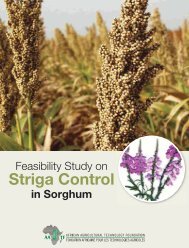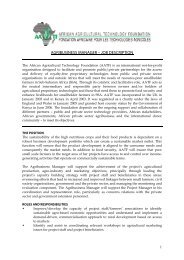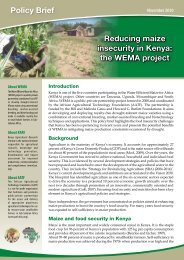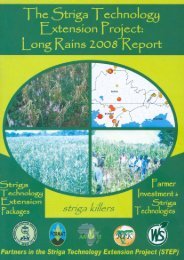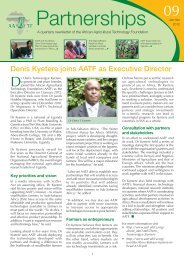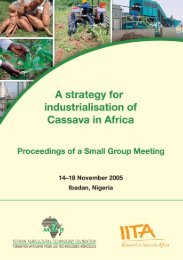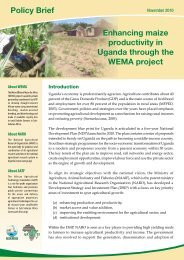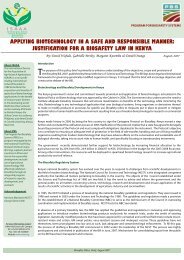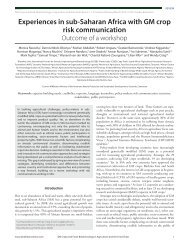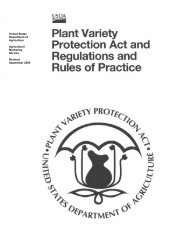Baseline Study of Striga Control using IR Maize in Western Kenya
Baseline Study of Striga Control using IR Maize in Western Kenya
Baseline Study of Striga Control using IR Maize in Western Kenya
Create successful ePaper yourself
Turn your PDF publications into a flip-book with our unique Google optimized e-Paper software.
<strong>in</strong>come for their livelihoods. A 10% <strong>in</strong>crease <strong>in</strong> the share <strong>of</strong> <strong>of</strong>f-farm <strong>in</strong>come <strong>in</strong> total <strong>in</strong>comereduces a household’s probability <strong>of</strong> be<strong>in</strong>g poor by about 34%. This implies that povertyreduction strategies must consider <strong>in</strong>come-earn<strong>in</strong>g opportunities for rural households beyondfarm<strong>in</strong>g and provide the needed access to capital to enhance rural households’ access to theseopportunities. Diversification <strong>of</strong> farm <strong>in</strong>come <strong>in</strong>to cash crops production is yet anotheravenue with<strong>in</strong> farm<strong>in</strong>g itself that could help reduce rural poverty. The results show that anadditional hectare <strong>of</strong> land under cash crops reduces a household’s probability <strong>of</strong> be<strong>in</strong>g poorby over 28%.The result relat<strong>in</strong>g to the positive relationship between credit and poverty confirms thatcausality runs from poverty to credit. Informal credit was <strong>in</strong>dicated by the sample householdsas one <strong>of</strong> their cop<strong>in</strong>g strategies <strong>in</strong> times <strong>of</strong> food shortage and shocks. Informal credit is part<strong>of</strong> a larger <strong>in</strong>ter-household cash as well as <strong>in</strong> k<strong>in</strong>d borrow<strong>in</strong>g and transfers that is used by thepoor to ma<strong>in</strong>ta<strong>in</strong> their productive capacity (that is human capital). Poverty reductionstrategies should consider strengthen<strong>in</strong>g such social and f<strong>in</strong>ancial capital assets <strong>of</strong> the poor.Agricultural technologies play a key role <strong>in</strong> poverty reduction. As expected, adoption <strong>of</strong>hybrid maize is significantly and negatively related to the dependent variable, imply<strong>in</strong>g thathouseholds adopt<strong>in</strong>g hybrid maize are more likely to come out <strong>of</strong> poverty. The results showthat adopter households <strong>of</strong> hybrid maize have a 24% lower probability <strong>of</strong> be<strong>in</strong>g poor thannon-adopter households. However, <strong>in</strong>creas<strong>in</strong>g <strong>in</strong>put-output price ratios follow<strong>in</strong>gliberalisation have had a negative <strong>in</strong>fluence on adoption <strong>of</strong> improved agriculturaltechnologies. While <strong>in</strong>creased <strong>in</strong>put-output market liberalisation has lowered food prices,<strong>in</strong>put prices have <strong>in</strong>creased due to the marg<strong>in</strong>al effect <strong>of</strong> <strong>in</strong>creased competition on market<strong>in</strong>gcosts relative to the effect <strong>of</strong> exchange rate devaluations and other reforms. The role <strong>of</strong><strong>in</strong>creased competition through private sector <strong>in</strong>volvement <strong>in</strong> improv<strong>in</strong>g market efficiency and<strong>in</strong> reduc<strong>in</strong>g <strong>in</strong>put prices for producers and output prices for consumers has been underm<strong>in</strong>edby the lack <strong>of</strong> public <strong>in</strong>frastructural development and support services such as credit andextension. Strategies have yet to be developed on how to make improved technologies suchas hybrid maize more pr<strong>of</strong>itable for farmers to ensure susta<strong>in</strong>able technology adoption underthe current food price dilemma <strong>of</strong> what level <strong>of</strong> food prices would make food more accessibleto the poor without compromis<strong>in</strong>g producer <strong>in</strong>centives and hence food supply.With regard to location effects on poverty, households <strong>in</strong> all districts except Vihiga districthave lower probability <strong>of</strong> be<strong>in</strong>g poor than those <strong>in</strong> Bondo, the district <strong>of</strong> reference <strong>in</strong> thisanalysis. The econometric results thus lend strong support to the descriptive result show<strong>in</strong>gthat Vihiga (82%) and Bondo (69%) have the highest level <strong>of</strong> poverty. Poverty analysisshows the proportion or households below the threshold <strong>of</strong> the two-third <strong>of</strong> average <strong>in</strong>comeper capita as a whole. Results for all the districts were computed on that overall average <strong>of</strong><strong>in</strong>come per capita. The results further show that only households <strong>in</strong> Bungoma have asignificantly lower probability <strong>of</strong> poverty compared with those <strong>in</strong> the reference Bondodistrict. This implies that poverty is less pervasive <strong>in</strong> Bungoma than <strong>in</strong> other districts,confirm<strong>in</strong>g its greater agricultural production potential.5.4 Household vulnerabilityVulnerability was assessed from two perspectives. The first considered the perception byrespondents <strong>of</strong> their vulnerability. Two parameters from the qualitative analysis wereconsidered: number <strong>of</strong> households affected by food shortages and frequency <strong>of</strong> foodshortages dur<strong>in</strong>g the year. The second perspective used a neutral assessment <strong>of</strong> nutritionalpoverty (as opposed to farmer perceptions). Two parameters on vulnerable groups <strong>of</strong>36




